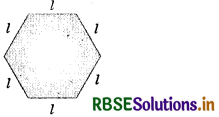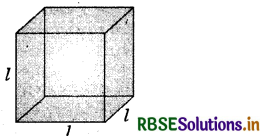RBSE Solutions for Class 6 Maths Chapter 11 Algebra Ex 11.2
Rajasthan Board RBSE Solutions for Class 6 Maths Chapter 11 Algebra Ex 11.2 Textbook Exercise Questions and Answers.
Rajasthan Board RBSE Solutions for Class 6 Maths in Hindi Medium & English Medium are part of RBSE Solutions for Class 6. Students can also read RBSE Class 6 Maths Important Questions for exam preparation. Students can also go through RBSE Class 6 Maths Notes to understand and remember the concepts easily. Students are advised to practice अनुपात और समानुपात के प्रश्न class 6 of the textbook questions.
RBSE Class 6 Maths Solutions Chapter 11 Algebra Ex 11.2
Question 1.
The side of an equilateral triangle is shown by I. Express the perimeter of the equilateral triangle using l.
Answer:
Side of equilateral triangle = l
Perimeter of equilateral triangle = Sum of lengths of sides of equilateral triangle
= l + l + l = 3l

Question 2.
The side of a regular hexagon in the figure is denoted by l.
Express the perimeter of the hexagon using l.
(Hint: A regular hexagon has all its six sides equal in length.)

Answer:
Side of hexagon = l
Therefore, perimeter of hexagon
= Sum of the lengths of all sides of hexagon
= 6 × sides of hexagon = 6l
Question 3.
A cube is a three-dimensional figure as shown in figure. It has six faces and all of them are identical squares. The length of an edge of the cube is given by l. Find the formula for the total length of the edges of a cube.

Answer:
Length of one edge of cube = l
Number of edges in a cube = 12
Therefore, total length of the edges of a cube = 12 × length of each edge = 12l

Question 4.
The diameter of a circle is a line which joins two points on the circle and also passes through the centre of the circle. (In the adjoining figure AB is a diameter of the circle; C is its centre.)
Express the diameter of the circle id) in terms of its radius (r).

Answer:
Diameter AB = AC + BC
⇒ d = r + r
⇒ d = 2r
Question 5.
To find sum of three numbers 14, 27 and 13 we can have two Ways:
(a) We may first add 14 and 27 to get 41 and then add 13 to it to get the total sum 54, or
(b) We may add 27 and 13 to get 40 and then add 14 to get the sum 54. Thus, (14 + 27) + 13 = 14 + (27 + 13).
This can be done for any three numbers. This property is known as the associativity of addition of numbers. Express this property which we have already studied in the chapter on whole numbers, in a general way, by using variables a, b and c.
Answer:
For any three whole numbers a, b, c, (a + b) + c = a + (b + c)
This property is known as the associativity of addition.

- RBSE Solutions for Class 6 Maths Chapter 2 Whole Numbers InText Questions
- RBSE Class 6 Maths Important Questions Chapter 1 अपनी संख्याओं की जानकारी
- RBSE Solutions for Class 6 Maths Chapter 7 भिन्न Intext Questions
- RBSE Solutions for Class 6 Maths Chapter 7 Fractions Ex 7.4
- RBSE Solutions for Class 6 Maths Chapter 1 Knowing our Numbers Ex 1.1
- RBSE Solutions for Class 6 Maths Chapter 1 Knowing our Numbers InText Questions
- RBSE Solutions for Class 6 Maths in Hindi Medium & English Medium
- RBSE Solutions for Class 6 Maths Chapter 7 Fractions InText Questions
- RBSE Solutions for Class 6 Maths Chapter 7 Fractions Ex 7.6
- RBSE Solutions for Class 6 Maths Chapter 7 Fractions Ex 7.5
- RBSE Solutions for Class 6 Maths Chapter 7 Fractions Ex 7.3